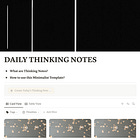Everyday Small Innovations
In every day’s life, there are plenty of opportunities for small innovations to make our life less frustrating, more productive, and more enjoyable.
At its core, innovation is a problem-solving exercise.
As a strategist, I often find myself asking :
Why couldn’t we ….
What may be a better way to ….
How might we ….
These have led me to innovate a few small things to solve my own problems - and along the way share these products with others with the same needs.
Below are 3 of these stories:
A 6-step Framework
Reflecting upon my own projects, I see that I’ve always followed a process. This framework is built upon a foundation of UX and Design Thinking - but is less formal and more flexible.
1. Start with Real Life
Many founders innovate to scratch their own itch. My starting point is always a lived experience where I notice friction (frustration) or repeated patterns in my or others’ behaviours.
For instance, I notice how my Facebook community always ask the same few questions, or how overthinkers like myself turn to writing to organize their thoughts.
2. Zoom in on the User and Problem
I don’t jump to solutions; instead, I explore the problem space.
I define the users and clarify:
what they are trying to do
where things break down
Then I articulate a clear problem statement such as “Users want to write free-form long notes without ending up with an unmanageable, disorganized collection.”
3. Define User Goals
Once I enter the solution space, I define Experience Goals instead of just features (this is where my UX background comes into play!)
Here are examples of well-worded user requirements (as opposed to a list of features)
“to write free-form notes”
“to easily review and find what they have written”
“to minimize stress”
4. Explore Technology and Tools That Fit the Context
I explore low-barrier, no-code, or resource-light solutions that fit the problem, the user, and the context. My choice focuses on practicality, investing in the most suitable tools to build a just-enough product.
For instance, I picked Softr and Airtable to build a table-centric webapp, and Cursor and Supabase for a more complicated webapp.
5. Design with Flow and Empathy
No matter how minor the product is, I walk through the user journey step-by-step and actively think through each user interaction and possible obstacles or confusion.
I consider issues like:
“What is the easiest way for a user to accomplish each step?”
“What could have gone wrong (and how to prevent it)?”
6. Iterate and Polish
I believe a good experience encompasses both form and function. Therefore, I pay attention to visual appeal and thoughtful secondary features. Iterations, especially with user feedback, help me polish the product towards its final form.
When possible, I view a product as a living system instead of a one-off build, improvements can continue to happen well after launch.
Final Thoughts
Innovation doesn’t have to mean big breakthroughs. Often, it starts with a small insight and a willingness to build something that solves a real problem.
I hope my 6-step framework will be a useful tool to accompany you along your innovation journey.







